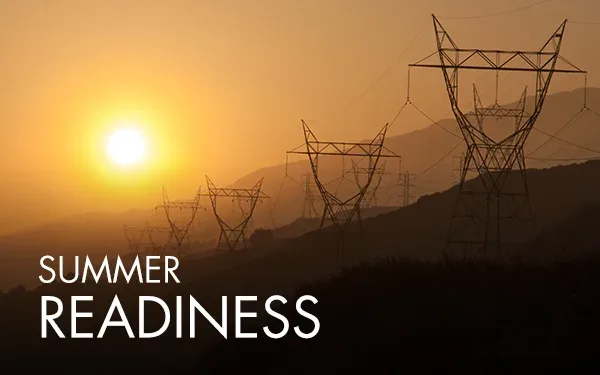2023 Summer Loads and Resources Assessment has been posted
The California Independent System Operator (ISO) has released its 2023 Summer Loads and Resources Assessment, which shows considerable improvement in resource availability for the upcoming summer, driven by accelerated resource development and high hydro conditions within California.
At this time last year, the Assessment was less optimistic about conditions for the approaching summer. That report said the ISO grid was an estimated 1,700 megawatts (MW) short of meeting the electricity industry’s “1-in-10” planning standard, which refers to systems having enough resources to experience no more than one outage every 10 years due to insufficient capacity.
As this year’s Assessment notes, the ISO is approaching the summer of 2023 with a moderate surplus for meeting that 1-in-10 standard, even as demand for electricity continues growing.
A primary reason for the improved conditions is the substantial amount of new capacity that has been added to the grid in the past year, including just under 3,000 MW of 4-hour lithium-ion batteries, which have helped enhance reliability.

During hot summer weather, power from the batteries is typically dispatched in the early evening, when the system is more vulnerable because temperatures and demand for electricity remain high while the sun is setting and the availability of solar power is declining.
Although some schedule delays are possible as we move through the summer, by September 1 the amount of storage capacity added to the grid since the prior September is projected to reach 4,302 MW. New solar capacity for that same September 2022 to September 2023 timeframe is expected to be 3,774 MW.
Another key reason for the more optimistic summer projections has been the record precipitation that California experienced this winter. Hydro conditions have trended to near-record highs in the state. On April 6 of this year, snow water content was 244% of normal for that day, providing the approximately 1,300 MW boost between average hydro conditions and current conditions.
Overall key findings in the 2023 Summer Assessment include the following:
- The ISO’s assessment of resource development demonstrates sound progress towards meeting the conventional “one day every 10 years” (“1-in-10”) Loss of Load Expectation (LOLE) planning target;
- Under current high hydro conditions, the resource fleet scheduled to be online by June 1, 2023 exceeds the 1-in-10 planning target with a margin of approximately 200 MW;
- Under current high hydro conditions, the resource fleet scheduled to be online by September 1, 2023 exceeds the 1-in-10 planning target with a margin of approximately 2,300 MW;
- Although load has grown from 2022 to 2023, these results represent a significant improvement from the 2022 Summer Assessment, when there was a shortfall in reaching the 1-in-10 planning target.
As the Assessment cautions, however, “These results do not take into account more extreme events such as those demonstrated in the last several years (e.g. extreme drought, wildfires and the continued potential for widespread regional heating events and other disruptions) that continue to pose a high risk of outages to the ISO grid.”

The ISO’s Summer Assessment is an annual report published and shared with State regulatory agencies, industry participants, and stakeholders and it fits into a broader collaborative effort on behalf of the ISO, California Public Utilities Commission (CPUC), and California Energy Commission (CEC) to prepare for summer system operations and maintain grid reliability.
In addition to focusing on added capacity and demand forecasts, the Assessment reports on other statewide efforts related to summer readiness. Since the widespread heat wave events of 2020, for example, and the extreme events encountered in subsequent summers, the ISO, State entities, and others have put in place a number of measures to strengthen system preparedness and performance.
These include approving procurement of additional resources, ensuring existing resources are retained in service, and improving operational readiness, and measures to access resources or load reductions that can be implemented when faced with the risk of shortfalls.
In this year’s Assessment, the ISO has added a focus on the year-over-year advances of new resource development and progress towards meeting resource planning targets in relation to the ISO’s traditional probabilistic operational risk analysis, which considers the latest available information on annual conditions, including hydro.
This Summer Assessment addresses three main issues:
- Overall progress towards resource planning targets;
- Operating reserve margin sufficiency at peak system conditions; and
- Operational risk assessment.
The Summer Assessment also includes updates on California’s Strategic Reliability Reserves and other extreme event measures, and preparation for summer 2023 operations.
In another example of efforts aimed at improving summer reliability across the grid, starting in the summer of 2021, several emergency resource programs also emerged which provide grid support during system emergencies and extreme events. These programs include the State Power Augmentation Project (SPAP), Electricity Supply Strategic Reliability Reserve Program (ESSRRP) managed by the Department of Water Resources (DWR), the Emergency Load Reduction Program (ELRP) developed by the CPUC, and the Demand Side Grid Support Program (DSGS) and Distributed Electricity Backup Assets Program (DEBA) administered by the CEC.
These emergency programs are triggered based on various ISO emergency notifications. In 2022, available measures were triggered by emergency conditions. In 2023, modifications are being made to allow triggering of some of these measures prior to – and potentially to help prevent – escalating to emergency conditions.
The ISO also undertakes a number of activities each year to prepare for summer system operations. These include fine-tuning market and operational metrics to ensure the effectiveness of the planned resource fleet in times of system stress and enhancing operational coordination with state agencies and the industry overall to access contingency reserves should the system face the risk of shortfalls due to more extreme events.
Other routine preparatory activities include coordinating meetings on summer preparedness with the Western Electricity Coordinating Council (WECC), California Department of Forestry and Fire Protection (Cal Fire), natural gas providers, utilities, transmission operators and neighboring balancing areas. The ISO’s ongoing coordination activities with these entities helps ensure readiness for the upcoming summer operational season.


